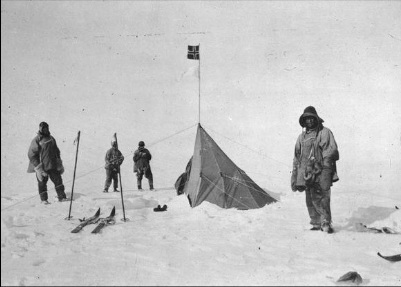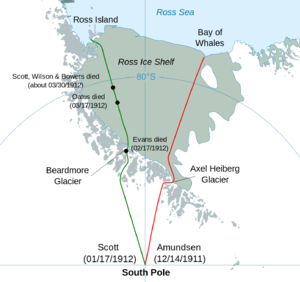Temperatures of minus 60 degrees, snow blizzards and its sheer remoteness make the south pole one of the most extreme places on earth. That’s why the southernmost point of the planet was one of the last places to be discovered by humanity. It was in the year 1911 when the Norwegian Roald Amundsen set foot in the South Pole as the first human. In parallel to Amundsen there was a second mission headed to the South Pole that has been led by the British officer Robert Scott. Later the story of these two antarctic missions became known as “a race to the South Pole” even though they were planned independently of each other. From today’s perspective the achievement of these explorers is quite remarkable considering that they couldn’t rely on modern transportation, clothing and technology a hundred years ago. This article will give you an insight about the different strategies of Amundsen and Scott as well as the hardships they had to face during their expeditions.

Scott led the official Antarctic Mission of the British Empire with the aim of reaching the South Pole but they also planned on doing scientific research along the way. On the 1st of November 1911 his party of five men left their base camp on Ross Island towards the Polar Plateau. Initially Scott had arranged motor sleds, ponies and dogs to carry their supplies. But the motor sleds and ponies failed under the extreme antarctic conditions and his men were not experienced enough with dog sleds which only left them the option of man-hauling their supplies. Going through that way of transportation for hundreds of kilometers in the arctic snow is quite energy consuming. Combined with the fact of insufficient food supplies that led to weight loss and hunger throughout the whole journey. In order to persist against the extreme temperatures Scott and his men relied on a double layer system with a warming wool layer covered by a windproof layer. After 77 days of marching Scotts party eventually reached the South Pole on the 17th of January 1912 only to discover that Amundsen had preceded them. These news hit the crew hard since they were already exhausted from man-hauling the sledges and their insufficient diet. But at this point they still had 1500 kilometers ahead of them to go back to the base which combined with unusually severe weather proved to be fatal. After one of the men had already died due to a fall finally the whole crew was froze to death in a blizzard shortly before reaching life saving supplies.

Roald Amundsen, who was already pretty experienced with the arctic conditions, chose a completely different strategy than Scott. Starting in the Bay of Whales his expedition crossed the shelf ice with dog sledges on a different route than the British Mission. Equipped with fur clothing in Inuit fashion the cold didn’t bother the Norwegian party. Amundsen’s plan furthermore included taking additional dogs with them that could be killed to gain food resources once they reached the Polar Plateau. Only 56 days after setting off Amundsen finally reached the South Pole on the 11th December 1911. Being more than 20 days faster than Scott dog sledges clearly proved to be the more effective transportation method. Amundsen erected a tent with the Norwegian flag and left a letter for Scott before they headed back to the Bay of Whales. The entire team returned safely to the sea and set sail for Australia. In Hobart, Australia they eventually announced the discovery of the south pole publicly not knowing about the fate of Scott.
Source: https://www.coolantarctica.com/Antarctica%20fact%20file/History/race-to-the-pole-amundsen-scott.php

